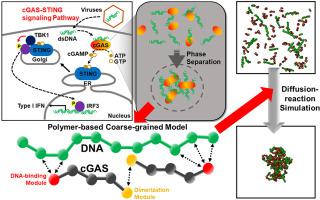Archives of Biochemistry and Biophysics ( IF 3.8 ) Pub Date : 2021-08-02 , DOI: 10.1016/j.abb.2021.109001 Zhaoqian Su 1 , Kalyani Dhusia 1 , Yinghao Wu 1

|
The enzyme cGAS functions as a sensor that recognizes the cytosolic DNA from foreign pathogen. The activation of the protein triggers the transcription of inflammatory genes, leading into the establishment of an antipathogen state. An interesting new discovery is that the detection of DNA by cGAS induced the formation of liquid-like droplets. However how cells regulate the formation of these droplets is still not fully understood. In order to unravel the molecular mechanism beneath the DNA-mediated phase separation of cGAS, we developed a polymer-based coarse-grained model which takes into accounts the basic structural organization in DNA and cGAS, as well as the binding properties between these biomolecules. This model was further integrated into a hybrid simulation algorithm. With this computational method, a multi-step kinetic process of aggregation between cGAS and DNA was observed. Moreover, we systematically tested the model under different concentrations and binding parameters. Our simulation results show that phase separation requires both cGAS dimerization and protein-DNA interactions, whereas polymers can be kinetically trapped in small aggregates under strong binding affinities. Additionally, we demonstrated that supramolecular assembly can be facilitated by increasing the number of functional modules in protein or DNA polymers, suggesting that multivalency and intrinsic disordered regions play positive roles in regulating phase separation. This is consistent to previous experimental evidences. Taken together, this is, to the best of our knowledge, the first computational model to study condensation of cGAS-DNA complexes. While the method can reach the timescale beyond the capability of atomic-level MD simulations, it still includes information about spatial arrangement of functional modules in biopolymers that is missing in the mean-field theory. Our work thereby adds a useful dimension to a suite of existing experimental and computational techniques to study the dynamics of phase separation in biological systems.
中文翻译:

DNA及其传感器蛋白cGAS驱动的相分离的粗粒度模拟
cGAS 酶起着传感器的作用,可识别来自外来病原体的胞质 DNA。蛋白质的激活触发炎症基因的转录,导致抗病原体状态的建立。一个有趣的新发现是,cGAS 对 DNA 的检测诱导了液体状液滴的形成。然而,细胞如何调节这些液滴的形成仍未完全了解。为了揭示 DNA 介导的 cGAS 相分离背后的分子机制,我们开发了一种基于聚合物的粗粒度模型,该模型考虑了 DNA 和 cGAS 中的基本结构组织,以及这些生物分子之间的结合特性。该模型进一步集成到混合仿真算法中。采用这种计算方法,观察到 cGAS 和 DNA 之间多步聚集的动力学过程。此外,我们系统地测试了不同浓度和结合参数下的模型。我们的模拟结果表明,相分离需要 cGAS 二聚化和蛋白质-DNA 相互作用,而聚合物可以在强结合亲和力下被动力学捕获在小聚集体中。此外,我们证明了可以通过增加蛋白质或 DNA 聚合物中功能模块的数量来促进超分子组装,这表明多价和内在无序区域在调节相分离中发挥积极作用。这与之前的实验证据是一致的。综上所述,据我们所知,这是第一个研究 cGAS-DNA 复合物凝聚的计算模型。虽然该方法可以达到超出原子级 MD 模拟能力的时间尺度,但它仍然包括平均场理论中缺少的关于生物聚合物中功能模块空间排列的信息。因此,我们的工作为一套现有的实验和计算技术增加了一个有用的维度,以研究生物系统中相分离的动力学。











































 京公网安备 11010802027423号
京公网安备 11010802027423号